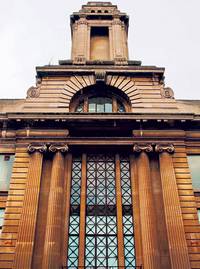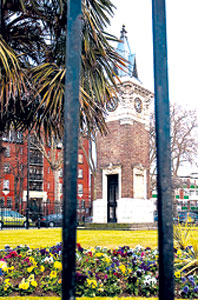Stepping out
in Stepney
By Graham Barker
22 March
On this springtime stroll you’ll encounter a giant egg, a huge spider’s web, sea-faring galleons and exotic palm trees. And there’s a chance too to meet a farm full of friendly animals.
As you emerge from Whitechapel Tube station, you’re immediately immersed in a bustle of fruit and vegetables, saucepans and saris. Facing you is the Royal London Hospital (1), built in the 1750s to treat the sick “merchant seamen and manufacturing classes” and now expanding into the blue glass towers behind the original site. Edith Cavell, pioneer nurse and World War I heroine, worked here.
Head left through the market and you soon pass under the dazzling blue and green glass canopy of Whitechapel Idea Store (2). Next door the gold lettering of Mann, Crossman & Paulin arches over the former Albion Yard brewery gate. And then comes the Blind Beggar pub (3), best known for Ronnie Kray’s 1966 shooting of rival gangster George Cornell.
Cross to the White Hart on the facing corner and continue along the wide pavement, beside a parade of London plane trees. Below the trees are two memorials – first a bust and later a preaching figure – of William Booth (4) who “commenced the work of the Salvation Army on Mile End Waste, July 1865”. The Army still provides shelter to the homeless at nearby Booth House.
Take a peek through the railings of Trinity Green Almshouses (5) on your left where tiny cottages with scrolled porches and dentilled eaves face each other across a green. They were built in 1695 for “28 decay’d Masters and Comanders of Ships or ye Widows of such”, which explains the model galleons above.
 Continue on, across Cleveland Way to the former Wickham’s department store (6) – “the Selfridges of the East End” – opened in 1927. With its classical columns and soaring tower it makes a spectacular sight, especially when floodlit at night.
Continue on, across Cleveland Way to the former Wickham’s department store (6) – “the Selfridges of the East End” – opened in 1927. With its classical columns and soaring tower it makes a spectacular sight, especially when floodlit at night.
The façade is broken by a white building squatting midway – the Speigelhalter brothers refused to sell up their jewellery shop here, so the store was built around them. The site is being renovated as The Water Lily retail, office and banqueting complex, with a glass atrium replacing the white shop. The Genesis Cinema comes next, one of London’s few remaining independent cinemas.
At the traffic lights, cross Mile End Road and then cross again to the far pavement of Stepney Green. Follow it right, and as it narrows you will reach the green itself. Take the path as it wanders between the trees. On your right is red-bricked Dunstan House (7), once home to anarchist Rudolph Rocker. To the left, pause by No 37 Stepney Green (8), an imposing Queen Anne house built in 1692 with a fine scallop shell over the front door.
As you leave the third green section, just after the former Stepney Jewish School, there’s Stepney Green Court (9), built by the Industrial Dwellings Company and embellished with decorative stone panels.
Cross, with care, to the art nouveau clock tower (10) commemorating local councillor and guardian of the poor, Stanley Atkinson, and surrounded by palms and pansies.
Follow the main road with football pitches on your right. Just before the street corner, enter Stepney Green Park and walk along the path with cityscape views to your right.
Leave the park via the side gate onto blue-cobbled Garden Street, facing Stepping Stones Farm (11). Skirt right around the green farm railings until you reach the main gate, passing Sir John Cass’ Foundation and Red Coat Secondary School along the way. The farm opens at weekends – and midweek too in the summer – so pop in to say hello to the pigs, goats and donkeys that live here.
Then cross carefully to the ancient St Dunstan and All Saints Church (12). With such a seafaring congregation it became known as the Church of the High Seas, and it still flies a red ensign flag. Its ten bells ring out “When will that be? Say the Bells of Stepney” in the Oranges and Lemons nursery rhyme.
Stroll right, along the tree-lined avenue, between verges peppered with colourful crocuses. Mercer’s Cottages (13) soon come into view, the gift of Lady Jane Mico, a mercer’s widow in 1691 and rebuilt as we see them today in 1856.
At the churchyard gates, turn left and walk through Whitehorse Open Space, towards a giant silver egg composed of leaf and bird cut-outs. At the egg, veer right to a pillar-box and then on past Cayley Primary School with its vibrant tile and mirror mosaic by the far gate. Look out for some footprints too as you follow Aston Street to Salmon Lane.
Go left under the railway bridge and take the third turning left into Carr Street. Use the silver footbridge to cross the canal, turn left behind the lock keeper’s house, and slope down onto the towpath.
Opened in 1820, the Regent’s Canal connects Limehouse Basin with the Grand Union Canal near Paddington. Your walk today follows just a short section, under the railway bridge and past the tall, solitary chimney.
Shortly before the road bridge, veer off between the daffodils towards the traffic lights, cross Rhodeswell Road and enter Mile End Park by the stone King George V gateposts. To your left the Ragged School Museum (14) re-creates the Victorian schoolroom first set up by Dr Barnardo.
Keep on the brown path as it runs between the sports pitches and racetracks. You slope upwards past a giant spider’s web – don’t worry, you won’t see a huge spider – though cucumber spiders, Brimstone butterflies and stag beetles do inhabit the park. By the green signpost, head right and join the main path running parallel to Burdett Road.
It’s currently aglow with a fabulous wave of yellow, white and purple crocuses. Head straight on at the bollards, along a woodchip path. At a row of turbine-topped lights follow the path right and leave the park beside the green bridge. Mile End station is a short distance ahead, across Burdett Road.
With thanks to Carlo Tono for trialling this walk.